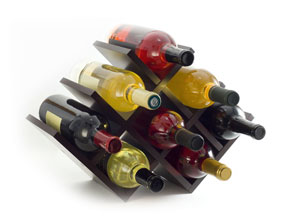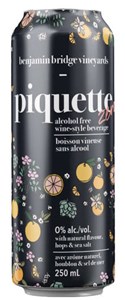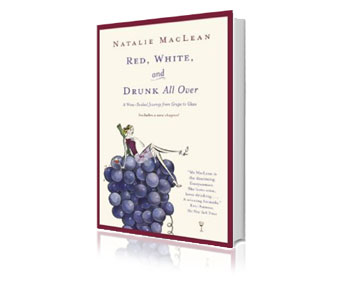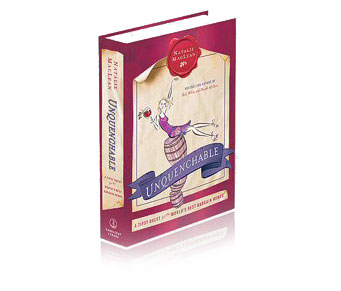Champagne Wine Pairing
The sparkling wine Champagne is named after the northern region of France where it’s produced. Other regions of France, as well as other countries, make sparkling wine, but only those from Champagne may be called Champagne.
Supposedly the eighteenth-century blind Benedictine monk, Dom Pérignon, accidentally discovered how to put the bubbles in Champagne when his wines started fermenting again in the spring after the cold winter had stopped them. Other records attribute this discovery to the British scientist Christopher Merret thirty years before Pérignon. Pérignon is credited widely with improving the techniques of blending wines from different years as well as the three principle grapes used: the white grape Chardonnay and two red grapes, Pinot Noir and Pinot Meunier.
The process today still involves a first fermentation to make the still, acidic wine. Then, before bottling, a small amount of wine, sugar and yeast is added (“liqueur de triage”) to trigger a second fermentation in the bottle, where the carbon dioxide bubbles are trapped.
The bottle is gradually tilted upside down (riddling), by hand or machine, and eventually the dead yeast cells gather in the neck and are disgorged so that the wine is clear. Before the final cork seal is affixed, the wine is topped up with a small amount of wine and sugar (liqueur d'expédition). The amount of sugar determines whether the bubbly will be Brut (very dry), Sec (off-dry) or Demi-Sec (medium-sweet).
Rosé bubbly is made either by blending red and white wine or by limiting the skin contact of the red grapes during maceration, when the grapes soak in their own juice before fermentation. Blanc de blancs Champagne is made only from Chardonnay while blanc de noirs is only from Pinot Noir and Pinot Meunier. The grapes for vintage Champagne that show a year on the label were harvested from one year only, while non-vintage Champagne are grapes and wines blended from many years. While Vintage Champagnes age well, non-vintage bubblies are meant to be consumed within a year or two of purchase while they still have their fruit freshness.
Many producers outside of the Champagne region use this process and grapes to make their bubbly and often put méthode traditionnelle on their label. The words Champagne and méthode champenoise may not legally be used by producers except those from Champagne itself. Bubblies made in Burgundy, France, are called Crémants de Bourgogne while those from Alsace are Crémant d'Alsace. Spain makes Cavas (“cave”), Italy makes either Prosecco (lightly sparkling) or Spumante (fully sparkling and sweet), Germany makes Sekt or Deutscher and those from New World regions, such as Canada, California, Australia and elsewhere, are simply called sparkling wine.
Some bubblies outside of Champagne are made from a cheaper and quicker carbonation process, during which bubbles are injected into the tanks of fermenting wines. This method doesn’t create wines with the same refinement and nuance as the Champagne method. The bubbles tend to go flat quickly.
Drink bubbly from a flute glass that preserves its bubbles and concentrates its aromas. (Forget those old coupe glasses molded to the shape of Marie Antoinette’s breasts.) Signature bubbly aromas include toast, yeast, fresh-baked bread, green apple, lemon, lime and orange zest.
Sparkling wine is one of the most versatile wines with food because of its zesty fruit aromas, mouth-watering acidity and palate-cleaning bubbles. Pair dry styles with quiche, spring rolls, almonds, canapés, brioche bread, Brillat Savarin cheese, goat cheese, chicken with creamy sauces, fried chicken, chicken tika, sashimi, Thai coconut shrimp, pasta with cheese-based sauce, caviar, crab, shrimp, clams, oysters, lobster, halibut, swordfish, scallops, seafood risotto, tuna with rosemary & citrus, nachos, potato chips, pretzels, onion rings, scrambled eggs with truffle oil, avocado salad, guacamole, pâté, grilled cheese sandwich, macaroni and cheese, turkey, charcuterie, veal piccata, salad nicoise and vegetarian casseroles. Sweet bubbly (doux or spumante) goes well with curries, fruit flans, cobblers, biscotti, nuts, soft cheeses, Christmas pudding, lemon soufflé, mille feuilles, pavlova and tiramisu.
Champagne Wine with appetizers:
• canapés
Champagne Wine with beef:
• tourtiere
Champagne Wine with breads:
• bread: brioche
Champagne Wine with cheese:
• blue: paradise
• brie
• Brillat Savarin
• camembert
• goat cheese
• Neufchatel
• Petit Morin
• Sablé du Boulonnais
• Sainte Maure
• swiss: baby
• Vieux Lille
Champagne Wine with chicken/poultry:
• chicken club sandwich
• chicken francese
• chicken with creamy sauces
• chicken with curry spices
• chicken: fried
Champagne Wine with desserts:
• chocolate: white
Champagne Wine with egg dishes:
• French toast & raspberries
• quiche
• quiche: spinach
Champagne Wine with ethnic dishes:
• Asian Dishes
• beef: Szechuan
• chicken tika
• deep fried food
• duck: peking
• latkes
• pork roast: Chinese
• ribollita
• sashimi
• shrimp: coconut: Thai
• spring rolls
• sushi
• tacos
• Thai dishes
Champagne Wine with nuts:
• almonds
Champagne Wine with pasta:
• pasta with butter-based sauce
• pasta with cheese-based sauce
• pasta with cream-based sauce
Champagne Wine with pizza:
• pizza: white
Champagne Wine with sauces, spices, herbs:
• anise, fennel
• cinnamon
• fennel
Champagne Wine with seafood & shellfish:
• caviar
• coquilles st. jacques
• crab
• crab salad
• fish: medium: grilled: like halibut, swordfish
• fish: white-fleshed
• lobster
• lobster in rich & creamy sauce
• lobster newberg
• lobster or salmon with hollandaise sauce
• lobster thermidore
• lobster with lemon & tarragon butter
• lobster with mayonnaise
• lobster with saffron
• oysters
• scallops
• scallops with rich sauces
• scallops with saffron
• seafood
• seafood brochettes
• seafood casserole
• seafood platter
• seafood/shellfish with butter or cream sauces
• shrimp, clams, oysters: fried
• tuna
• tuna with rosemary & citrus
Champagne Wine with snacks:
• nachos
• potato chips
• pretzels
Champagne Wine with vegetables & salads:
• broccoli mornay
• onion rings
• salads
• spinach souffle
Would you like to
browse wines available in stores now that match these dishes?
Do you want to search for
recipes that have a complementary ingredient to your search?
Find out how to
post your own copy of the web-based Drinks Matcher widget on
your computer desktop, web site, blog or social media page such as Facebook, MySpace or iGoogle.
 Best Books of the Year
Best Books of the Year Best Books of the Year
Best Books of the Year















